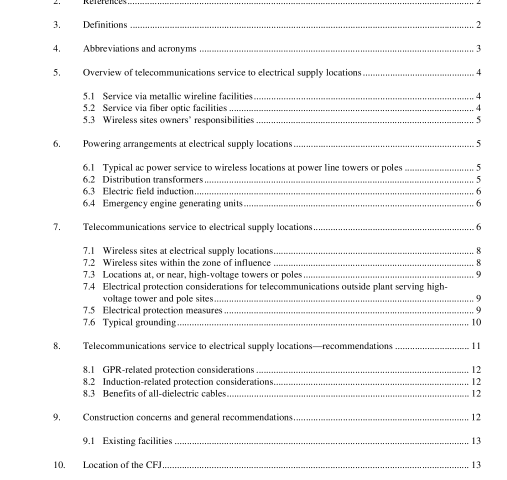IEEE 1590-2003 pdf download.IEEE Recommended Practice for the Electrical Protection of Optical Fiber Communication Facilities Serving, or Connected to, Electrical Supply Locations
5. Overview of telecommunications service to electrical supply locations
Telecommunications service to electrical supply locations is provided via a link that connects the telecom- munications equipment located at, or near, the electrical supply location with the central office or switching center of the telecommunications service provider. Although telecommunications services to an electrical power station include a large variety of types (see Annex B), telecommunication services to a wireless cell site are usually DS-1 or DS-3 type circuits. The telecommunications facility may be either a metallic wire line cable, an optical fiber cable, or a microwave system.
Wireless cell sites are established at a variety of locations, including some at, or near, power line transmis- sion and distribution structures such as towers or poles. These locations typically have a telecommunications facility that connects the associated electronic equipment, or BTS, with the wireless switching center, either directly or through a telecommunications central office (see Ashdown et al. [B1] and Bellarmine and Lee [B2]).
5.1 Service via metallic wireline facilities
When the telecommunications facility consists solely of a metallic wireline cable, then IEEE Std 487-2000 is used to determine the level of electrical protection needed at the electrical supply location.
5.2 Service via fiber optic facilities
The use of a fiber optical system to serve an electrical supply location should be considered when the band- width requirements of wireline facilities are exceeded. In addition, the fault producing the GPR and induction at the electrical supply location may exceed the capability of the metallic wireline facility. In an electrical supply location environment, a fiber optical system may be viewed as both a communications transport medium and isolation protection, assuming proper methods for metallic facilities are deployed.
5.3 Wireless sites owners’ responsibilities All wireless installations shall comply, at a minimum, with NEC and NESC requirements to ensure person- nel safety in all aspects of the installation.
NOTE — Canadian Electrical Code Parts I, II, and III, or other applicable local codes may also be applicable. The owner shall also ensure that NESC requirements are met with respect to access, approach distances, and qualified personnel around energized facilities.
The owner of the tower and/or pole shall accept responsibility for the overall coordination of work to be done on, or at, their site. At electrical supply locations (power stations and power line transmission and dis- tribution structures such as towers or poles), the owner shall provide the expected GPR, the electrical characteristics for determining touch, and step potential information. All work off the ground on the power line towers or poles, including placing and routine maintenance oper- ations, shall be performed by qualified or licensed personnel. 6. Powering arrangements at electrical supply locations Electrical supply locations have a variety of powering arrangements. Electrical power locations typically have local power systems, either ac or dc, for the equipment located within the site. For reliability purposes, the local power is usually backed-up. Power sources at, or near, power line towers or poles need special con- siderations (see 6.3).
6.1 Typical ac power service to wireless locations at power line towers or poles
The commercial power to a wireless site is often a single-phase 120/240 V secondary service with the cen- ter-tapped neutral bonded to the primary MGN at the distribution transformer and grounded at the wireless site. This secondary neutral provides a path for the transfer of high potential during line-to-ground faults at a tower. Studies (van Waes et al. [B21], [B22]) have shown that when OGW (static or lightning wires) are employed, the distribution low-voltage conductors may carry one-third of the current back to the source transformer. Without overhead grounding conductors, they are the primary discharge path.
6.2 Distribution transformers
The enclosures housing the electronic equipment require ac power that is typically provided through a distri- bution transformer. If a flashover occurs on the high-voltage system, the resulting fault current may travel to the distribution neutral conductor. If the fault current is of sufficient magnitude and the neutrals are not properly isolated, serious damages could occur to homes or businesses in the neighborhood (down the line from the distribution transformer). As the distribution transformers often feed adjacent customers, they may become a part of the return circuit. Distribution transformers located in close proximity to high-voltage transmission towers and used to provide ac power to an electronic equipment enclosure (also located in close proximity to high-voltage transmission towers) shall have the neutrals separated by a spark gap or similar device.IEEE 1590 pdf download.IEEE 1590-2003 pdf download
IEEE 1590-2003 pdf download

Leave a Reply